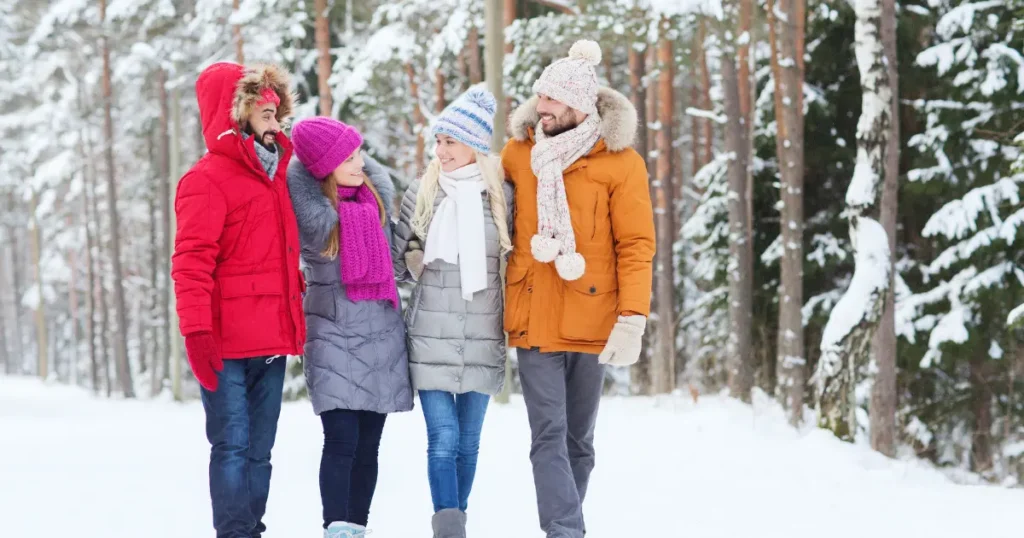Winter is a season that brings chilly weather, shorter days, and the opportunity to bundle up in cozy clothing. Choosing the right winter wardrobe can be both fun and challenging, especially when trying to balance warmth, comfort, and style. This guide will help you understand the best clothing options for winter, ensuring you stay warm and fashionable throughout the cold months.
Why is Winter Clothing Important?

Winter clothing is essential for several reasons, the most important being protection against cold weather. Proper winter attire helps regulate body temperature, reduces the risk of cold-related illnesses, and keeps you comfortable during outdoor activities. Additionally, winter clothing can also be a form of self-expression, allowing you to showcase your style even in colder months.
Factors to Consider When Choosing Winter Clothing
When selecting winter clothing, it’s important to consider the following factors:
Warmth:
The primary function of winter clothing is to keep you warm. Look for items with good insulation properties.
Comfort:
Ensure your winter clothing is comfortable for long wear. This includes soft fabrics and a proper fit.
Breathability:
Winter clothing should allow moisture to escape while keeping warmth in. This helps prevent sweating and chills.
Weather Resistance:
Opt for clothing that can withstand snow, rain, and wind. Waterproof and windproof materials are ideal.
Style:
Winter clothing doesn’t have to be drab. Choose pieces that reflect your personal style and are versatile enough to mix and match.
Layering
One of the best strategies for staying warm in winter is layering. Layering allows you to add or remove clothing as needed to maintain a comfortable temperature.
Base Layer
The base layer is the first layer of clothing that touches your skin. Its primary function is to wick moisture away from your body to keep you dry.
- Materials: Merino wool, synthetic fabrics like polyester, or blends that are designed for moisture management.
- Function: Prevents sweat from making you cold by keeping your skin dry.
Middle Layer
The middle layer is responsible for trapping body heat and providing insulation. This layer can be adjusted depending on how cold it is outside.
- Materials: Fleece, down, or synthetic insulation like PrimaLoft.
- Function: Retains body heat and provides warmth.
Protection Against the Elements
The outer layer, also known as the shell layer, protects against wind, rain, and snow. It should be both waterproof and windproof while still allowing moisture to escape.
- Materials: Gore-Tex, eVent, or other waterproof and breathable fabrics.
- Function: Shields you from harsh weather conditions while allowing sweat to escape.
Top Winter Clothing Items
A good winter coat is essential for staying warm during the cold months. Here are some popular options:
Down Jackets:
- Pros: Extremely warm and lightweight.
- Cons: Can lose insulation properties if wet.
- Best For: Very cold and dry climates.
Wool Coats:
- Pros: Stylish, breathable, and warm.
- Cons: Not ideal for wet conditions unless treated.
- Best For: Mild to moderately cold conditions, and when you want to look dressy.
Parka Coats:
- Pros: Insulated, often with a hood, and designed for extreme cold.
- Cons: Can be bulky.
- Best For: Extreme cold and outdoor activities.
Sweaters and Hoodies
Sweaters and hoodies are versatile winter essentials that can be worn alone or as part of a layering system.
Wool Sweaters:
- Pros: Excellent insulation and moisture-wicking properties.
- Cons: Can be itchy for some; requires special care when washing.
- Best For: Cold weather layering or as a standalone piece in mild cold.
Fleece Hoodies:
- Pros: Lightweight, breathable, and warm.
- Cons: Less wind-resistant unless treated.
- Best For: Casual wear or layering under a shell jacket.
Thermal Underwear
Thermal underwear is a crucial base layer that provides extra warmth during cold days.
- Materials: Merino wool, synthetic blends.
- Function: Keeps your body heat close to your skin while wicking away moisture.
Winter Pants and Trousers
Winter pants should provide warmth while allowing for easy movement. Here are some options:
Insulated Pants:
- Pros: Provides extra warmth for very cold conditions.
- Cons: Can be bulky.
- Best For: Outdoor activities like skiing or snowboarding.
Wool Trousers:
- Pros: Warm, breathable, and stylish.
- Cons: Not suitable for wet conditions unless treated.
- Best For: Office wear or formal occasions.
Accessories: Hats, Gloves, and Scarves

No winter outfit is complete without the right accessories. They help protect extremities that are often most vulnerable to cold.
Hats
- Types: Beanies, trapper hats, and earflap caps.
- Best Material: Wool, fleece, or synthetic blends.
Gloves
- Types: Mittens (warmer) and gloves (more dexterous).
- Best Material: Leather, wool, or insulated synthetic materials.
Scarves
- Types: Infinity scarves, wool wraps, and cashmere scarves.
- Best Material: Wool, cashmere, or knit fabrics.
What Shoes are Best for Winter?
Choosing the right footwear for winter is crucial to prevent slips and keep your feet warm and dry.
Winter Boots:
- Pros: Insulated, waterproof, and often equipped with non-slip soles.
- Cons: Can be heavy and less breathable.
- Best For: Snowy and icy conditions.
Waterproof Shoes:
- Pros: Lighter than boots and still offer protection against wet conditions.
- Cons: Less insulation compared to boots.
- Best For: Mild winter conditions with occasional snow or rain.
Shearling-Lined Boots:
- Pros: Extremely warm and comfortable.
- Cons: Not suitable for very wet conditions.
- Best For: Dry, cold climates and casual wear.
Winter Footwear Table
| Type of Footwear | Best For | Pros | Cons |
|---|---|---|---|
| Winter Boots | Snowy, icy conditions | Insulated, waterproof, non-slip soles | Heavy, less breathable |
| Waterproof Shoes | Mild winter, wet conditions | Lighter, waterproof | Less insulation compared to boots |
| Shearling-Lined Boots | Dry, cold climates | Warm, comfortable | Not suitable for wet conditions |
How to Choose the Right Winter Fabrics
The fabric you choose for winter clothing plays a major role in how warm and comfortable you will be. Here are some of the best fabrics for winter:
Wool:
- Pros: Naturally warm, breathable, and moisture-wicking.
- Cons: Can be itchy; requires special care.
- Best For: Sweaters, coats, and accessories.
Fleece:
- Pros: Lightweight, warm, and quick-drying.
- Cons: Less wind-resistant unless treated.
- Best For: Mid-layers, jackets, and hoodies.
Down:
- Pros: Extremely warm and lightweight.
- Cons: Loses insulation when wet; requires special care.
- Best For: Jackets and vests.
Synthetic Insulation:
- Pros: Insulates even when wet, easier to care for.
- Cons: Can be bulkier and less breathable.
- Best For: Jackets, pants, and gloves.
Cashmere:
- Pros: Soft, luxurious, and warm.
- Cons: Expensive; requires special care.
- Best For: Sweaters, scarves, and accessories.
What Not to Wear in Winter
Wearing the wrong clothing in winter can lead to discomfort or even health risks. Here are some items to avoid:
Cotton:
- Why Avoid?: Cotton absorbs moisture and holds it against your skin, making you feel colder.
Non-Insulated Shoes:
- Why Avoid?: These shoes offer little protection against the cold and can lead to frostbite in extreme conditions.
Tight-Fitting Clothes:
- Why Avoid?: Tight clothes restrict circulation and reduce the insulating effect of air between layers.
Fashion Over Function:
- Why Avoid?: While looking good is important, never prioritize style over warmth and comfort in extreme weather.
Conclusion
Choosing the best clothing for winter is about balancing warmth, comfort, and style. Understanding the importance of layering, selecting the right fabrics, and knowing what to avoid can make a significant difference in your winter experience. Whether you’re braving extreme cold or enjoying a mild winter day, the right clothing will keep you warm, dry, and comfortable. Remember, winter is not just a season to endure—it’s an opportunity to showcase your style while staying cozy and protected against the elements.
By carefully selecting your winter wardrobe, you can confidently face whatever winter throws your way, from snowstorms to chilly winds, all while looking your best. Stay warm, stay stylish, and enjoy the winter season.
Frequently Asked Questions (FAQs)
Here are some frequently asked question given below:
What should I wear in extreme cold?
In extreme cold, focus on layering. Start with a moisture-wicking base layer, add an insulating middle layer, and finish with a windproof and waterproof outer layer. Don’t forget to protect your extremities with hats, gloves, and thermal socks.
Can I wear sneakers in winter?
Sneakers can be worn in mild winter conditions, but they are not ideal for snow or icy conditions as they lack insulation and traction. Opt for winter-specific shoes or boots instead.
How do I keep my feet warm in winter?
Wear insulated, waterproof boots, and use thermal socks made of wool or synthetic materials. Adding a moisture-wicking liner sock can also help keep your feet dry and warm.
Is wool better than synthetic materials for winter clothing?
Wool offers excellent warmth, breathability, and moisture-wicking properties, making it a great choice for winter. However, synthetic materials can be more durable and easier to care for, especially in wet conditions.
How can I maintain my winter clothes?
Follow care instructions on the label. Wool and down often require gentle washing and air drying, while synthetic materials may be machine washable. Proper storage, such as using garment bags for wool, can help extend the life of your winter clothing.
